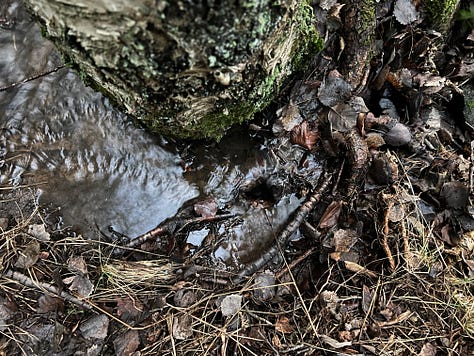

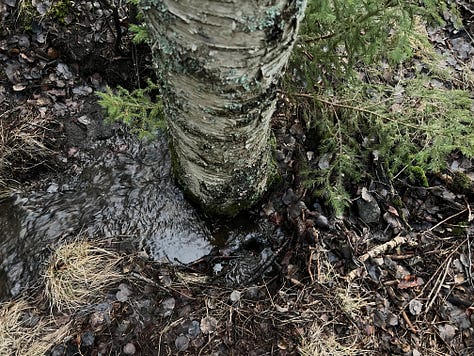
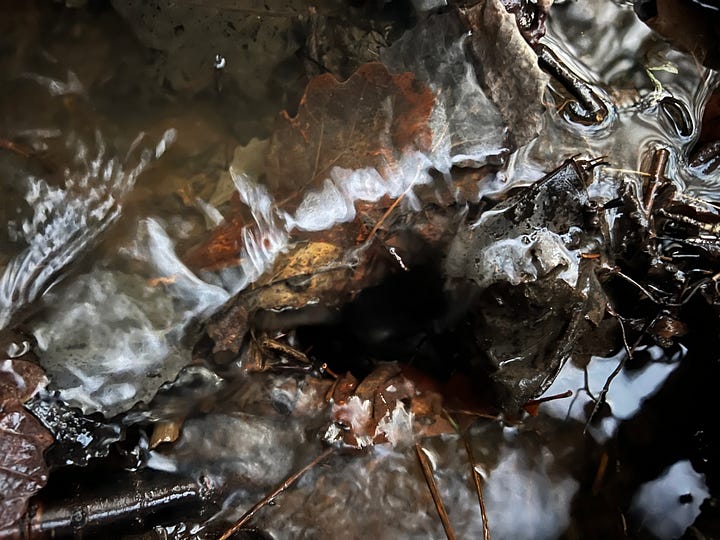
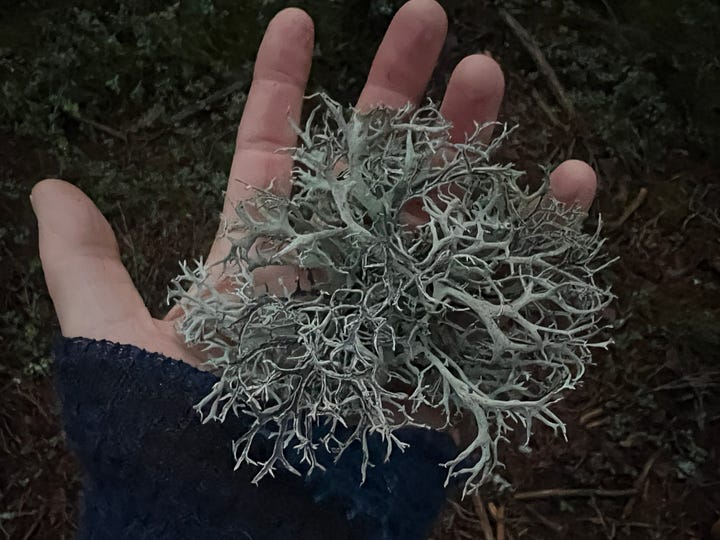
I'm hit by the swell of it, a wave of desire to write, while walking to the spring with my family. It's Christmas day and +8 degrees celcius, about 25 degrees warmer than it was this time last year. Amidst the sense of alarm, something poetic is moving but I've no way to grasp it now, no paper to hold it down, no pen to pin it with. There is nothing to do but notice the movements of this big fish writhing, in the small pool of the torso. Sensing the full body flicks and tickle of the tail. Resisting the urge to wrestle it to the death and make it my catch. I'll write when I get home to keep the pool from stagnating, but the water will already have moved and the fish perhaps will have lept.
It must have come through the birch, this fish, while I was pressing my ear hard to the bark skin. Listening to the bone conducted sound of the stream, through the birch standing in the middle of the flow. This creek ran dry in the summer, as did the forest spring when the moss and lichen became crisp and crumbly. Our neighbours who've lived here 30 years say it's a first. Now, instead of waterfalls of icicles, the stream flows strong. I press my head to trunk and branch myself to this resonance. Sound waves of water wash through my body; from ear bone, to skull and spine, throughout my whole skeleton. For a moment I am an echo chamber of this little river. Stream sounds play with pulse rhythms, flooding tissues and veins, rinsing arteries and organs. Perhaps the birch itself is articulated sound, perhaps all trees are shapes of sounds or living records of sonic waves that have moved them into being.
I show Esmilda how to do it, to press the ear hard to the trunk to receive it. 'The tree is a speaker'' she remarks. The tree speaks stream in rhythmic babble babble, a language the body is well versed in. The stream pools around the buttress of the birch, then makes a sudden dive, funnelling down between the roots. Canalised under the path, perhaps through plastic tubing, but from the surface all we see is roots imbibing the stream. I close my eyes with ear branched, following the resonant babble babble through the root funnel underground. Swimming deep in something dark and familiar, till I surface on the other side. Knee deep in the Styx River, drinking from this wild water, brown with the tannins of roots and leaves.
It's not the Styx River of death but of the living, temperate rainforest of lutrwita Tasmania. Apparently colonisers named it after the sticks in the river then later given a twist of Greek myth. Either way, sticks and death is what clear-fell logging is doing to this ancient forest. Eucalyptus regnans - the tallest flowering trees on earth, deciduous myrtle, tree ferns and countless other species. Some are pulped for paper and the rest are burnt to make way for a monoculture of plantation forests. It's November 2019 and Patrick and I are preparing for a collaborative art project - Styx Lament, soon to be joined by 14 Tasmanian-based artists, activists and academics and our Swedish collaborator Tomas, to make sonic and somatic rituals in what was once old-growth forest.
We wade out into the river with listening sticks in hand, dipping one end in the flow and holding the other tight to the ear bone. The river song transmits directly - through bone conduction. This practice of listening to rivers through sticks was introduced to Patrick by Norman Lowrey, during a Deep Listening workshop. Not the Aboriginal practice of deep listening known as 'Dadirri', but the practice devloped by American composer, Pauline Oliveros. Though culturally divergent, there is a parallel in listening as a spiritual practice.
While listening to the river in the shade of the bridge and sounding what we hear with our voices, we hear cars pull up above us. Doors slam and we bring our session to a close, emerging sheepishly as trolls from under the bridge. Someone is telling stories about the Styx to a group of people, we edge a little closer to listen. Squinting in the sun I recognise the silloette of Bob Brown – a legendary environmentalist. He's yarning with the recipients of this year's environmental awards, presented by his foundation, telling them now about the time he got lost paddling on this river. We get chatting after a while and I try to explain what we are up to, making performance art rituals in the felled and burnt forest, to not abandon these damaged places, to address ecological grief. To lean into it and listen - how do we practice the rites and rights of nature? – does the fallen forest still resonate?
Art seems abstract by comparison, frivelous perhaps. The heroics of environmentalism is a clear narrative. It's an honour to meet such a bunch of legends on this bridge, with the wild river flowing strong beneath us. Their work has directly contributed to saving forests and land from exploitation, they have raised awareness and engaged through direct action. While we are knee deep in the strangeness of sonic and somatic grieving practices, wading in something awkward, dark and culturally taboo. Not as an alternative to activism, more as a parallel path. By comparison our mission seems questionably insignificant, though just maybe essential. This positioning of under and over the bridge stays with me and I wish my creaturing self had been less shy and invited them down in the water with us to listen.
Spiralling back up through the funnel, back to the stream, back to the birch. There's this sense of all the water of the earth as one and the same. This stream meets the river on the other side of the planet, connected by ripples in my body, or this is the same water that has travelled through clouds and oceans, through my body and yours, through dinosaurs and tree ferns. The memory of time and place through water. I'm reminded of a birch on an island I skied to years ago, who spoke while I rested with my back to their trunk, ''all the life in your blood, all the life in your blood''. All the life of all the rivers coursing through our blood.
We continue our walk to the spring - Patrick, Esmilda and I, with Minuit the kitten in tow. We pour the canister for each other, sipping from the stream of water so as not to contaminate the cup. The water is fresh and delicious. We've never had it tested, but the body says YES! We do have water from our borr well at home, but nothing compares to the water freely offered, percolated by earth and filtered by forest. Usually we collect drinking water from a spring that we can drive to, at Lötbodal or Tullgarn. But this one hidden in the forest seems all the more sweet for our walking.
A few days later I'm back with two containers, filling them from the concrete form where the spring water pools, where I spot a small toad swimming, perhaps adding sweetness. Scooping them up to rest on the moss, I wonder if I saved them or just disturbed their morning swim. I walk the few kilometers back home with a few liters of toad water in each hand, remembering Vatt-Anna. I met a picture of this water carrying woman in Torekällberget (Tore mountain spring) museum, where we will exhibit in the coming year. The text reads - 'Carrying water was hard work. Those who could afford it were happy to hire water carriers. The carriers charged per bucket. One of them was Vatt-Anna. With buckets and a yoke, Vatt-Anna carried water from Tore spring and the Turinge pump to finer houses in the city. When she got older and could no longer support herself, she ended up in the poorhouse at Artursberg. Photographer: unknown. Photo date: late 1800s. It's not yet clear what we will make for the exhibition, but in some way I wish to honor Vatt-Anna the water carrier, perhaps by carrying the water for her. To honor her bones conducting water.
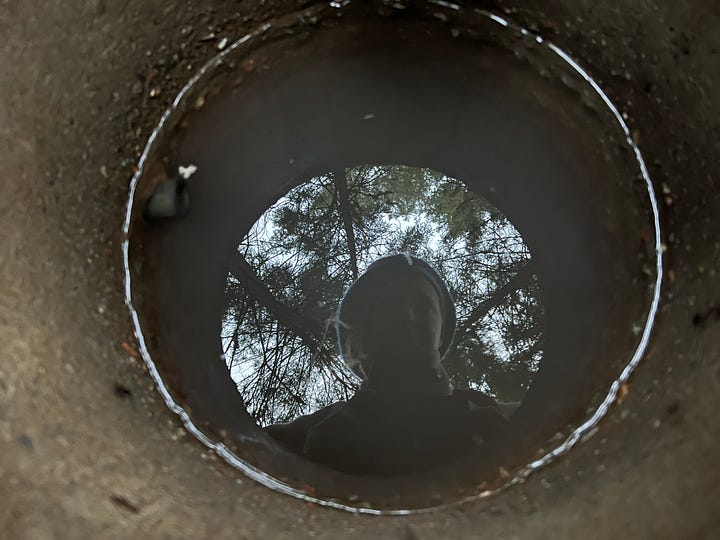

((center for resonance)) is brought to you from an off-grid yurt in the Swedish forest. Subscribe for fortnightly delights in you inbox, delivered every new and full moon. All posts are free but if you’d like to support our creative endeavours with your comments, likes or paid subscription, that would warm the very cockles of my heart and encourage the words to keep flowing.




Thank you Julia. Such a rich meditation.
Resonances everywhere…
Performance art. Ritual. Mourning.
In addressing the hesitance/connection between activism, ritual, ecological performance art you also offered yet another small piece of a puzzle in a longstanding emotional and mental debate I have as environment activist and artist.
And now, presently; led by an interest which was initially stirred by the sound recordings of my teenage grandchild, I am reading Sounds Wild & Broken by David George Haskell.
This new engagement with the sounds of the world has in turn led me to your work. Once again, thank you.
Beautiful essay on water - the staff of life. I have been fascinated by new research on water as consciousness by Veda Austin, building on Masaru Emoto's work. She has shown how it communicates with us in pictographic form using a partial-freezing technique based on the intentions infused in it. And now, your musing that explores sonic infusions--in blood and bone. Fascinating, Julia. Can't wait to hear more about your coming art installation